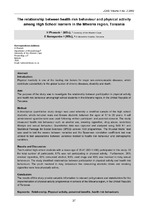| dc.contributor.author | Pharaoh, Hamilton | |
| dc.contributor.author | Nannyambe, Edgar | |
| dc.date.accessioned | 2017-05-02T13:37:49Z | |
| dc.date.available | 2017-05-02T13:37:49Z | |
| dc.date.issued | 2009 | |
| dc.identifier.citation | Pharaoh, H. & Nannyambe, E. (2009). The relationship between health risk behaviour and physical activity among high school learners in the Mtwarra region, Tanzania. Journal of Community and Health Sciences, 4(2): 37-43 | en_US |
| dc.identifier.issn | 1990-9403 | |
| dc.identifier.uri | http://hdl.handle.net/10566/2777 | |
| dc.identifier.uri | http://jchs.epubs.ac.za/index.php/jchs/article/view/60/53 | |
| dc.description.abstract | INTRODUCTION: Physical inactivity is one of the leading risk factors for major non-communicable diseases, which
contribute substantially to the global burden of chronic diseases, disability and death.
AIM: The purpose of the study was to investigate the relationship between participation in physical
activity and health risk behaviour among high school students in the Mtwarra region, in the United
Republic of Tanzania.
METHOD: A descriptive quantitative study design was used whereby a stratifi ed sample of the high school
students, which included male and female students between the ages of 17 to 26 years. A self
administered questionnaire was used following written participant and parental consent. The study
measured health risk behaviour such as alcohol use, smoking cigarettes, drug abuse, sedentary
lifestyle and sexual behaviour. Quantitative data was captured and analyzed using SAS 9.1 and
Statistical Package for Social Sciences (SPSS) version 13.0 programmes. The Kruskal- Wallis` test
was used to test the means between variables and the Spearman correlation coefficient test was
utilized to test associations between variables related to health risk behaviour and demograp hic
variables.
RESULTS AND DISCUSSION: Two hundred high school students with a mean age of 20.47 (SD=1.493) participated in this study. Of
the total number of participants, 67% was not participating in physical activity. Furthermore, 26%
smoked cigarettes, 93% consumed alcohol, 9.5% used drugs and 93% was involved in risky sexual
behaviours. The study identified relationships between participation in physical activity and
health risk behaviours. The youth involved in risky behaviours like consuming alcoholic drinks and
smoking cigarettes were less physically active.
CONCLUSION: The results of this study provide valuable information to relevant policymakers and stakeholders
for the implementation of physical activity programmes in schools of the Mtwarra region, in the
United Republic of Tanzania. | en_US |
| dc.language.iso | en | en_US |
| dc.publisher | University of the Western Cape | en_US |
| dc.rights | This journal provides immediate open access to its content on the principle that making research freely available to the public supports a greater global exchange of knowledge. | |
| dc.subject | Relationship | en_US |
| dc.subject | Physical activity | en_US |
| dc.subject | Perceived benefits | en_US |
| dc.subject | Health risk | en_US |
| dc.subject | Behaviours | en_US |
| dc.title | The relationship between health risk behaviour and physical activity among high school learners in the Mtwarra region, Tanzania | en_US |
| dc.type | Article | en_US |
| dc.privacy.showsubmitter | FALSE | |
| dc.status.ispeerreviewed | TRUE | |

